The Magimix Juice Expert 3 is our new favourite appliance - here's why
The Magimix Juice Expert 3 is one of the best centrifugal juicers you can buy
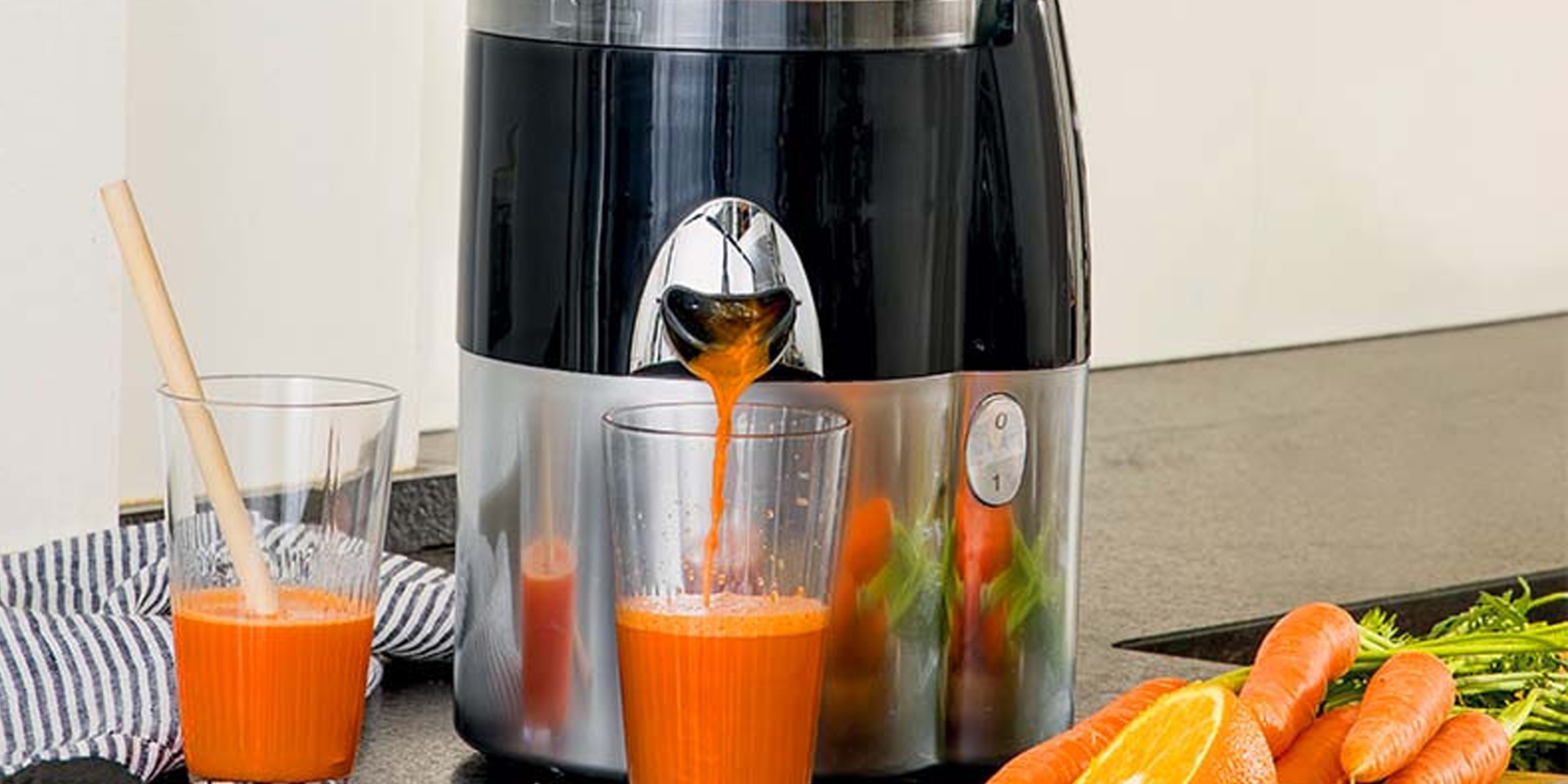
The Magimix Juice Expert 3 impressed me with excellent juice yields as well as smooth tasty juices. It’s simple to use, comes with loads of recipes, and the citrus press is a brilliant added extra. It’s a versatile machine that can even be used for pulpier, smoothie style drinks or nut milks.
-
+
Citrus press included
-
+
Small footprint
-
+
Quality construction
-
+
Single speed operation
-
+
Excellent juice yields
-
-
Expensive for a centrifugal juicer
-
-
Pulp has to be removed frequently
Why you can trust Ideal Home

We’ve all heard of Magimix food processors, they’re some of the best around, but you might not know you can buy a Magimix Juicer. It makes sense though, juicing technology is not dissimilar to the way many food processors work.
The Magimix Juice Expert 3 is a centrifugal juicer with a twist. Traditionally centrifugal juicers are seen as the poorer performing cousin of the cold press or masticating slow juicer. Centrifugal juicers typically extract less juice but are also said to destroy nutrients thanks to the heat generated by the fast spinning mechanism. Here, Magimix has developed ColdPress technology to make more of a hybrid style centrifugal juicer and I like it.
I’ve been using this juicer for a week or so and it’s far more versatile than your average juicer, you’ve probably already guessed from the 5 stars that I’m a fan. So scroll down to see why I like it so much and why I think it’s worth paying a bit extra for this, one of the best juicers over others.
Magimix Juice Expert product specs
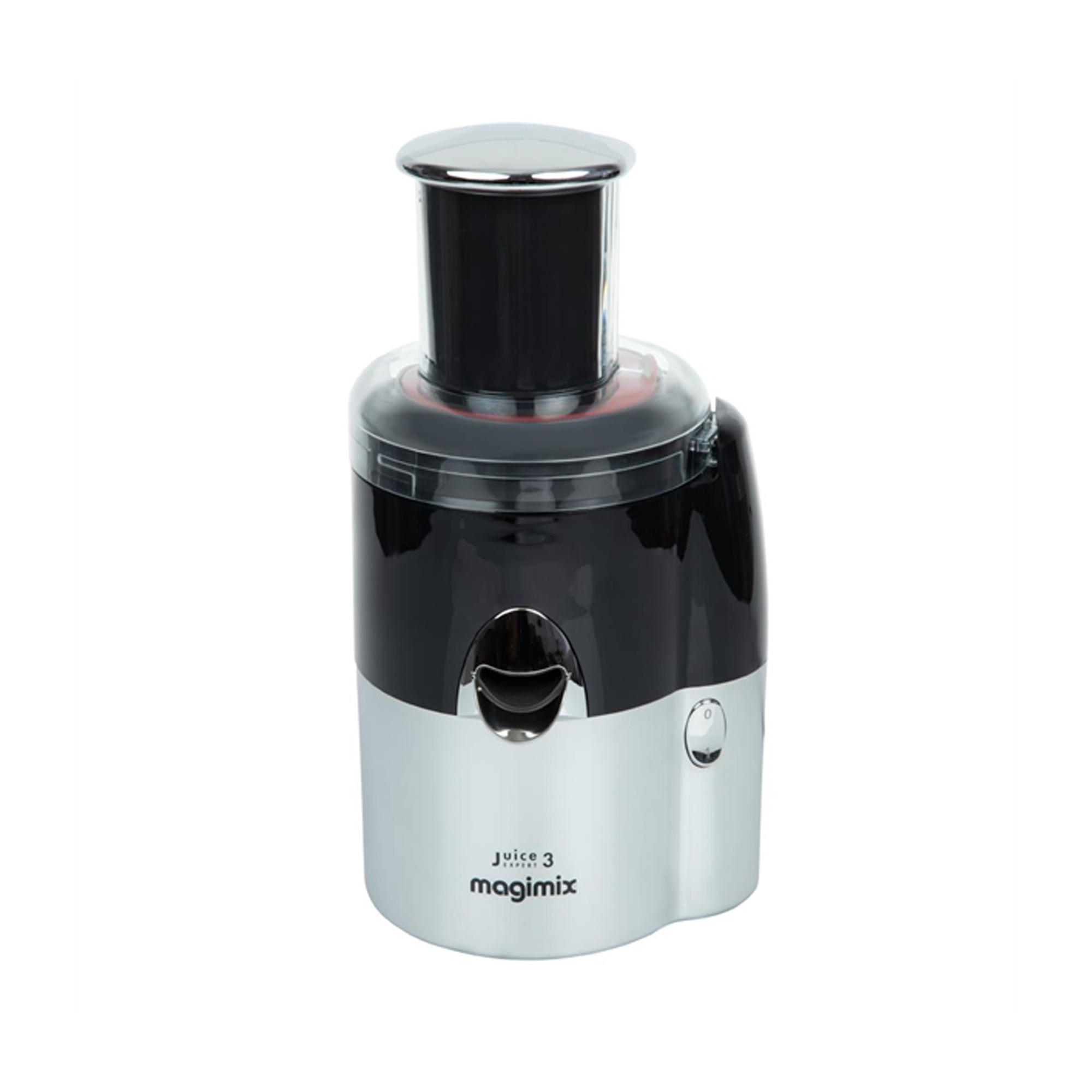
- Centrifugal or Masticating: Centrifugal – cold press
- Material: Plastic and stainless steel
- Capacity: Pulp capacity listed by amount of fruit it can juice before emptying eg: 1.5kg apples/ 0.6kg spinach/ 4kg strawberries
- Feeding tube: oval 90 x 75mm
- Power: 400 Watts
- Weight: 7.5kg
- Dishwasher safe: yes
- Accessories: Citrus press and extra press
- Other features: Recipe book included, 30-year motor guarantee
Who tested this juicer

After completing a Home Economics degree, Helen went on to work for the Good Housekeeping Institute and has been reviewing home appliances ever since. She lives in a small village in Buckinghamshire in the UK and Magimix loaned her the juicer for two weeks for the review.
Unboxing
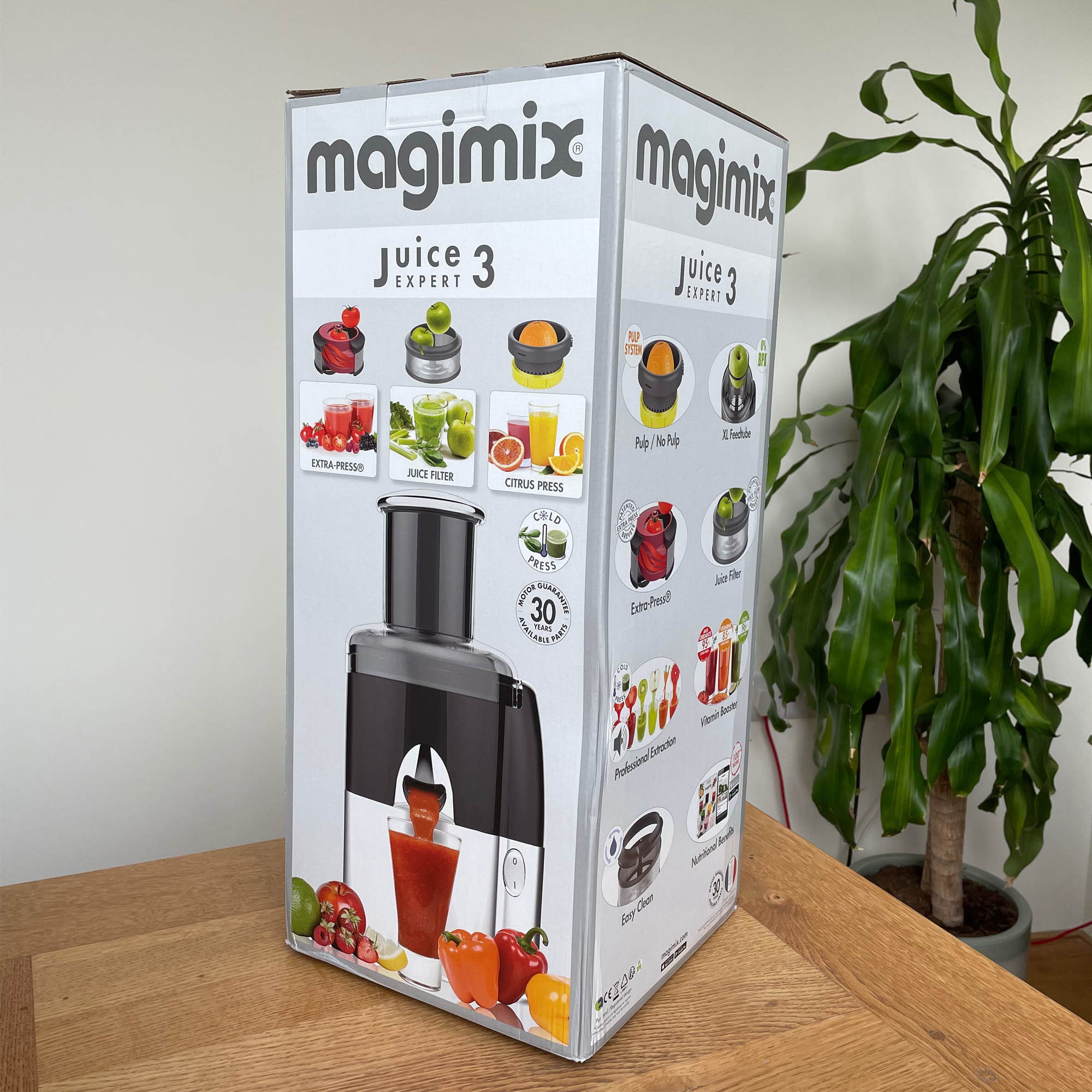
The Magimix Juice Expert 3 comes in a small but tall box, and it has some weight to it. Sadly this juicer and I didn’t get off to the best of starts when I opened the box and found my pet hate – polystyrene. This destined-for-landfill packaging is not what I wanted to find, come on Magimix, surely you can do better than this?
Putting that to one side, the juicer itself appears to be well made and has a sturdy, weighty quality. It didn’t take me long to figure out how the parts slot together – partly because it comes out of the box fully assembled. But also because it goes together intuitively, with all the parts twisting into place in a set up that’s not surprisingly reminiscent of putting together a food processor.
Once it’s all out of the box and set up, it’s tall but slender. It doesn’t take up much more space on the worktop than your average kettle. Though keep in mind that it’s tall, so might not slot beneath wall cabinets, and the citrus press attachment is an extra thing to store.
Part of me is disappointed that there’s not a jug included for collecting the juice, but having said that I’m always complaining about my overflowing cupboards and I already have jugs. Plus the spout is at the right height to pop a glass below it, so on reflection I don’t think I mind.
First impressions
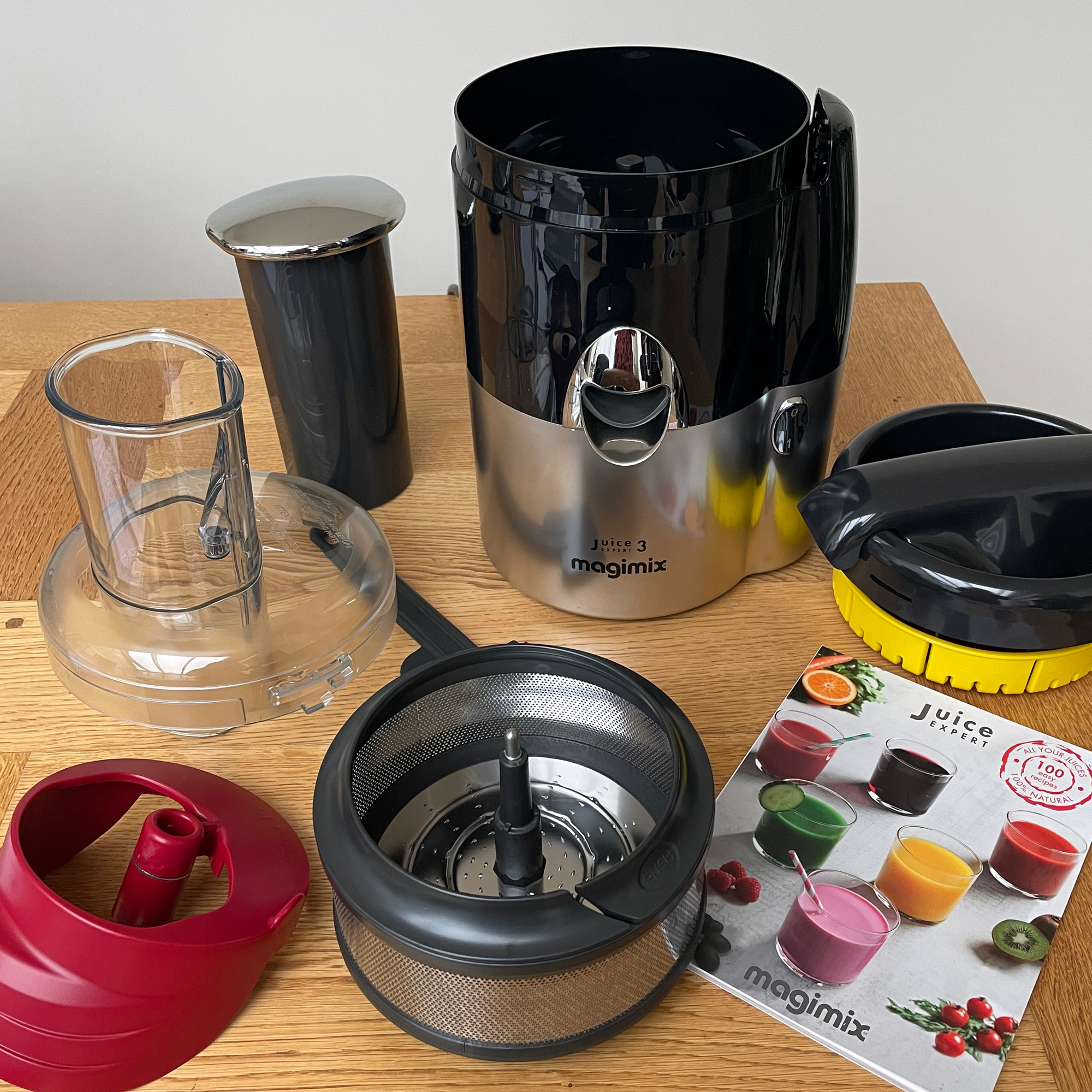
I’m pleased to see a recipe book included. The 100 recipes offer plenty of inspiration and guidance that’ll really help you to make the most of this juicer.
With no pulp container, all the pulp stays inside the filter, so the whole thing has to be disassembled when it gets full. From what I can see, it will fill quickly as it’s not a big space. So I’m immediately thinking this won’t be a juicer for huge batches, though to be honest I’m not sure how many people are juicing big boxes of fruit regularly anyway. And having looked through the instructions, it does state it can cope with 1.5kg of apples before it’ll need emptying, which is better than I thought.
There’s another design detail that for me is lacking - there’s not a drip stop. Which means as soon as you remove your glass or jug from below the spout, any rogue drips will inevitably end up on the worktop. It’s a small niggle but is a feature that could easily have been included in the design.
Aside from the main juice filter, the red ‘extra press’ attachment is a nifty part which pushes more pulp through and means you can juice traditionally tricky foods like berries, mango, and banana into a pulpier smoothie style drink. What’s more, with a citrus press attachment included in the box, this is shaping up to be a multi-tasking juicer.
Making apple juice
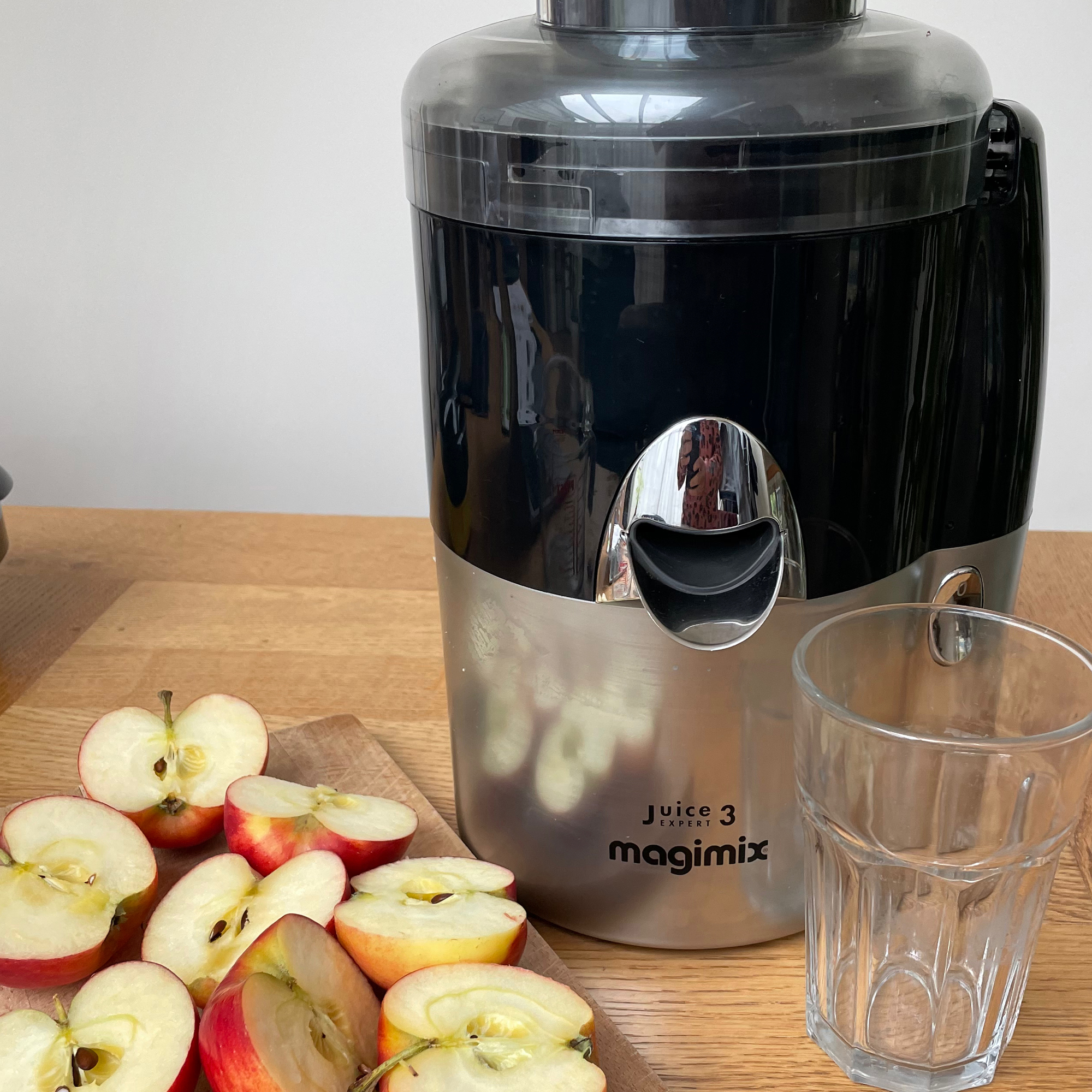
Despite having an extra wide feed chute, apples still need to be cut in half because of a bit that juts out and stops them passing all the way through. I’m not going to complain about cutting apples in half though, it doesn’t exactly take long.
The juicing process took around 1 minute 30 seconds for four apples, which is longer than I expected. And I had to keep a firm pressure applied to the pusher throughout. It hit 82dB on my noise meter, which is typical for a juicer – it’s about the same noise level as a blender.
I weighed the apples before juicing as well as my glass of juice and worked out that 72% of the apples made it into the glass, so only 28% is waste pulp. It’s an impressive yield that’s up there amongst some of the best juice yields I’ve seen for apples.
There was some froth on top, but below that, the juice was deliciously sweet and though the appearance was cloudy, the texture was very smooth.
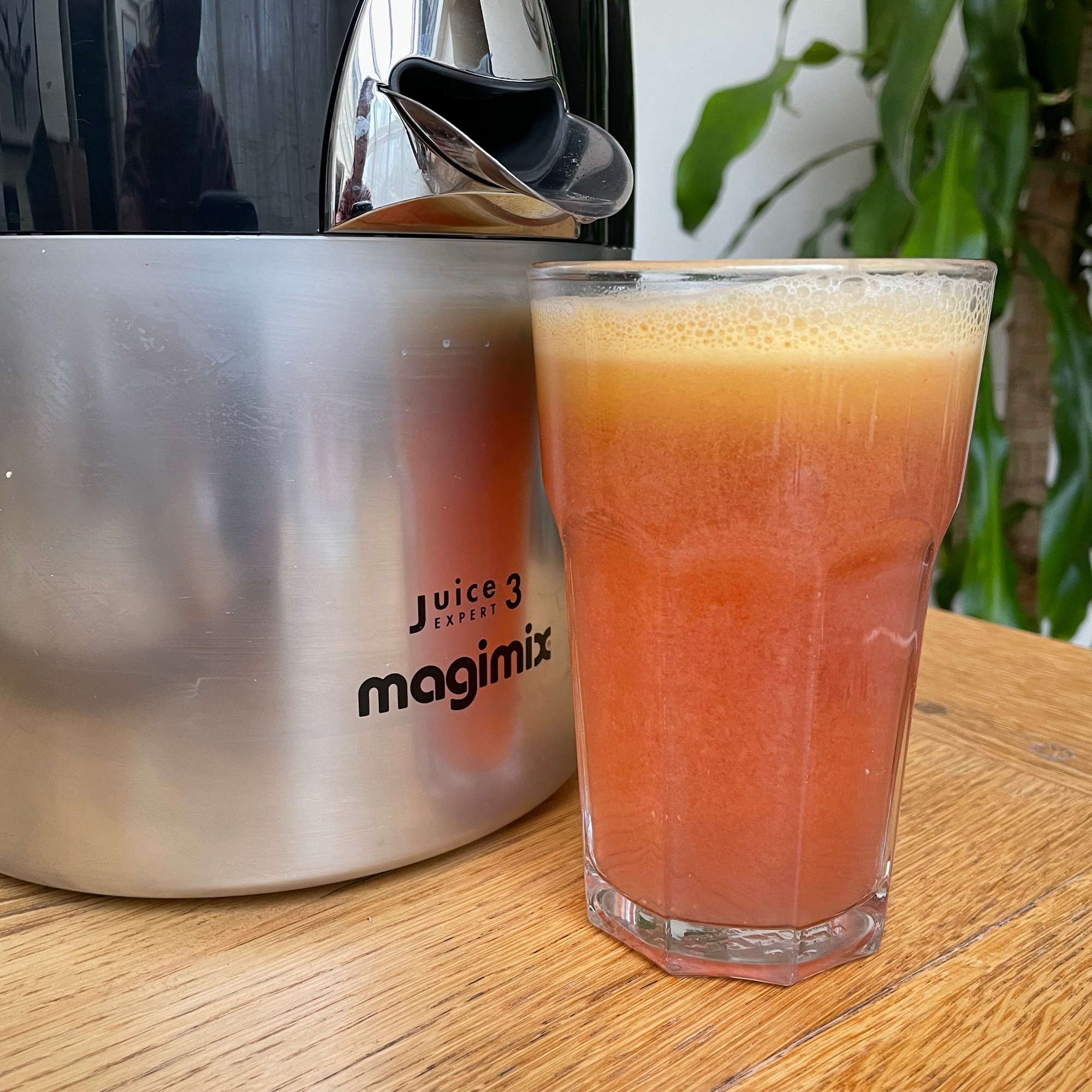
Squeezing orange juice
I’m so happy this juicer comes with a citrus press, juicing oranges in other centrifugal juicers can be quite wasteful but this is brilliant.
It took just over a minute to juice four oranges. I found the process slightly fiddly because after juicing each orange half, the juicer needed to be switched off so I could remove the orange skin, then replace it with the next orange, before switching back on again.
I did notice that not all the flesh of each orange had been juiced and I think the results will depend on the size of your oranges as well as how well you centre the orange half on the juicing cone. If it’s off centre, the juicer won’t do as good a job.
The juice comes out pulpy which I love, but if you only like smooth juice, it won’t be the one for you. Thankfully it’s not aerated and foamy like it often is when you make orange juice in a centrifugal juicer and I’m very happy with the results. In case you’re wondering, the noise level was similar to when juicing apples.
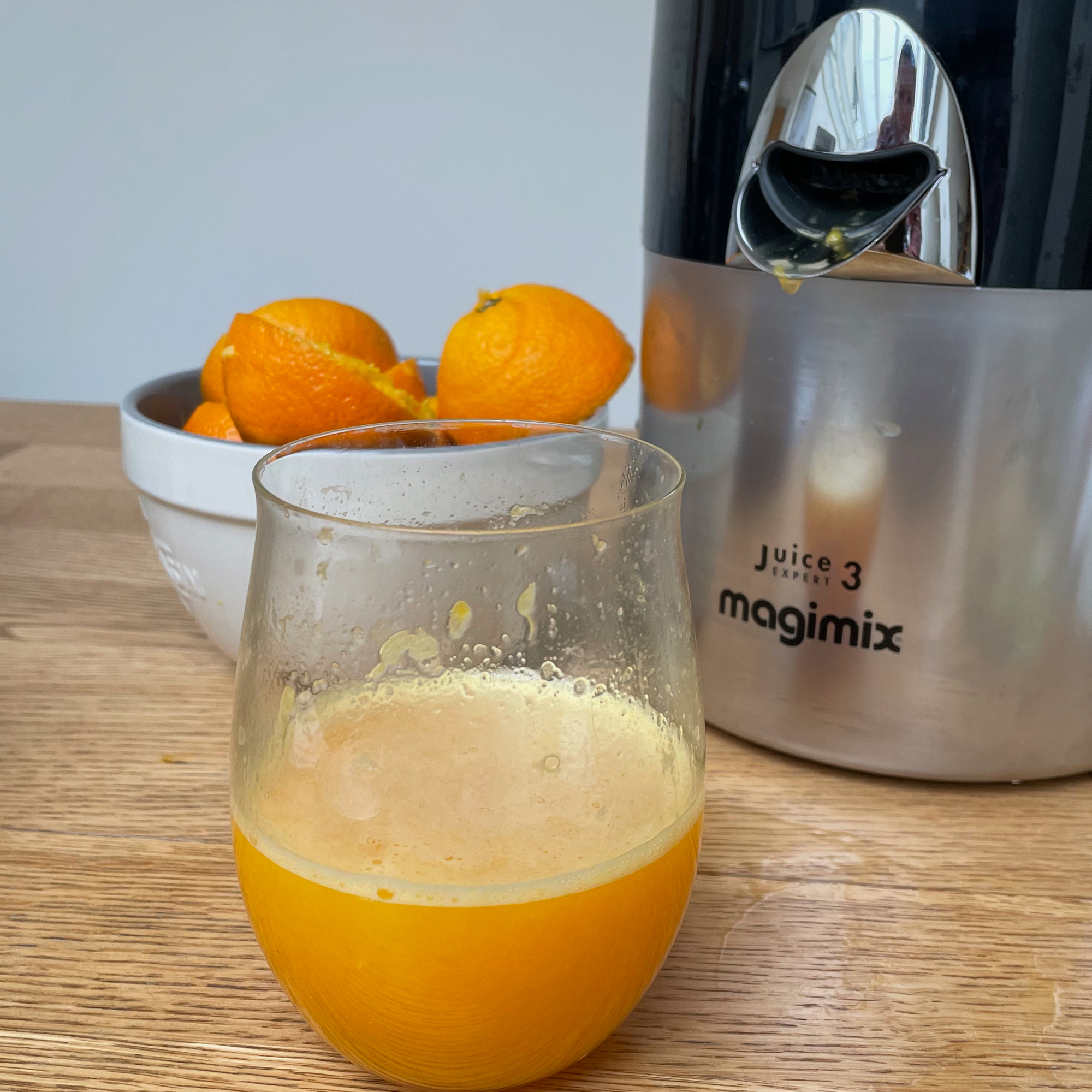
Making a vegetable juice
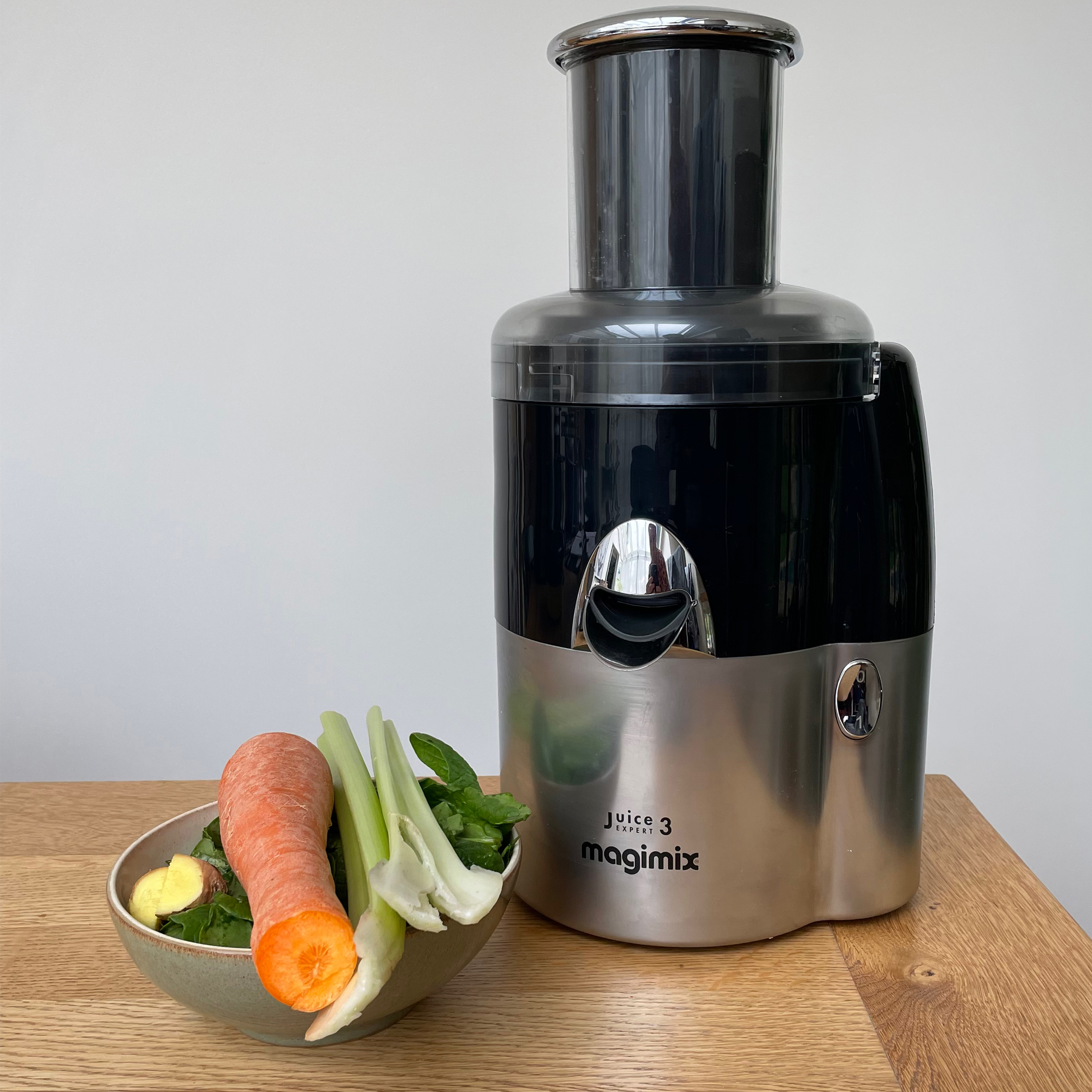
Not all juices should be sugary sweet, so for balance, I made a mixed vegetable juice consisting of celery, carrot, spinach and ginger. I cut a thumb size piece of ginger in half, but other than top and tailing the carrot, left everything whole.
It took a slow two and a half minutes to juice everything and I had to keep pushing firmly on the pusher for the entire time, which I think made it feel longer. At the end I left it running for a further 30 seconds to allow all the juice out. But it was worth it because the 64% juice yield is by far the best I’ve achieved for this particular juice - across a range of different juicers.
Not only did it produce the juice with minimal waste, but there was also very little froth and the juice tasted deliciously smooth and clean. I could taste just a few teeny specs of pulp but it’s one of the clearest I’ve tasted.
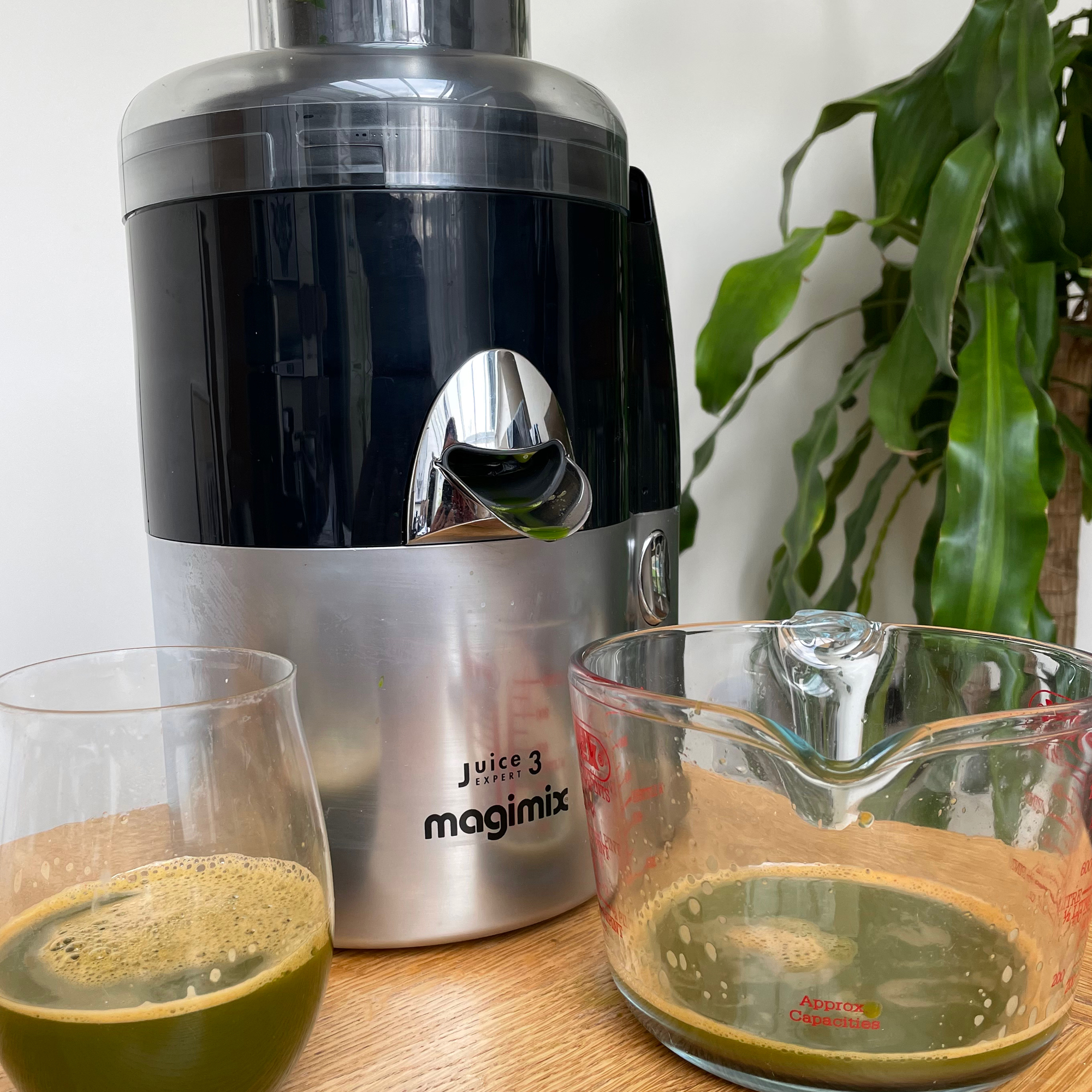
Juicing raspberries
The red ‘extra press’ insert is designed for soft fruits such as berries, so I put it to the test with a whole 300g pack of raspberries. It took around 1 minute 30 seconds and created a thick smooth raspberry puree and with a yield of 73% it’s probably the most effective juicer I’ve ever used for juicing raspberries.
There’s very little waste other than the seeds, which is impressive, there were a few berries stuck in the centre, but I can forgive this given how effective it was. It’s is a fantastic gadget for removing the seeds from berries when making fruit coulis as well as desserts.
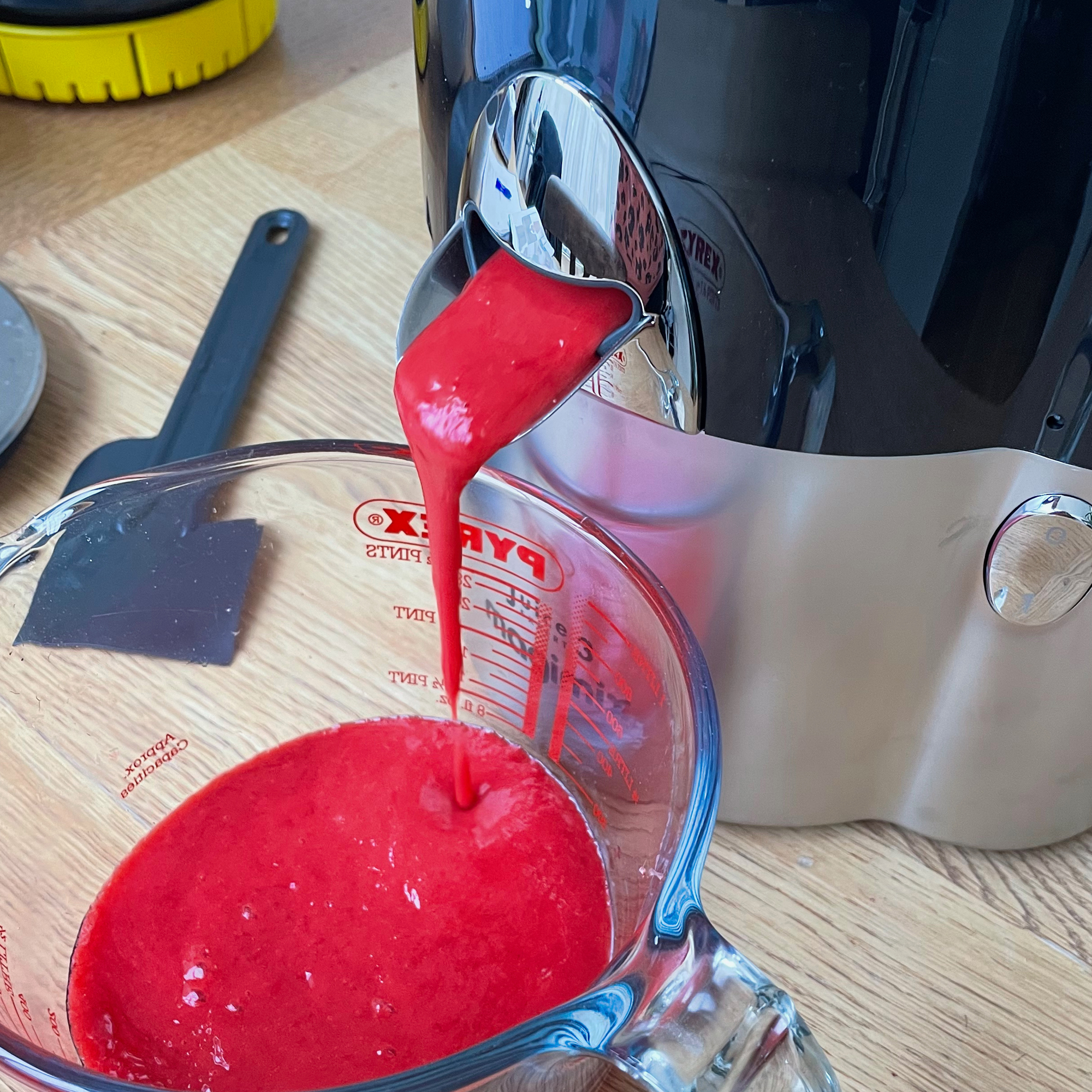
Making nut milk
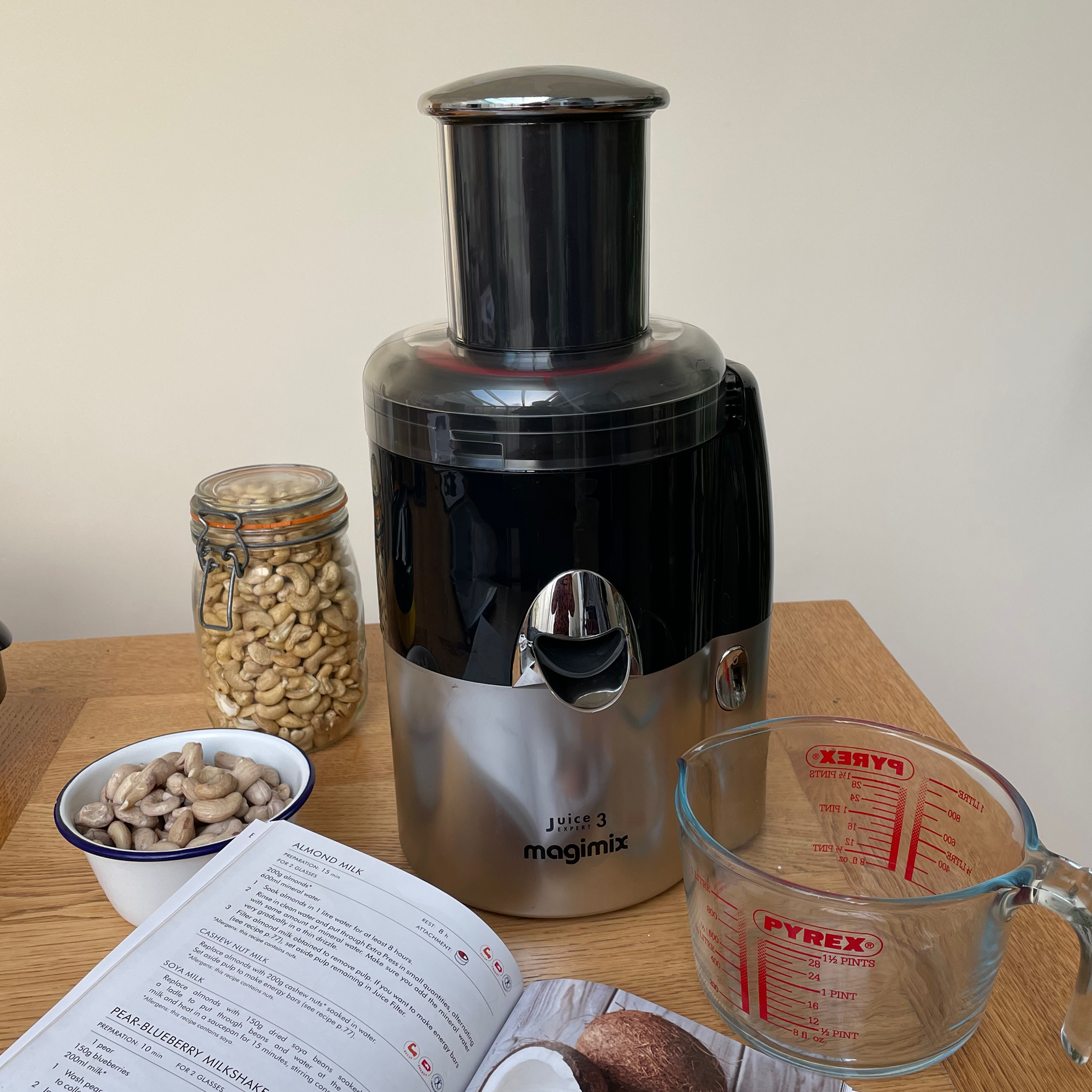
Although I’m a nut milk convert, I’ve never made my own. I’ve always sat firmly in the ‘life’s too short’ camp. But when I saw you could make nut milk in the Magimix I was intrigued. The recipe book gives a recipe for almond as well as cashew milk and I chose cashew.
After soaking my 200g nuts overnight in water I made sure the ‘extra press’ attachment was in position and started loading them into the juicer whilst also pouring in a stream of water. After a couple of minutes I had a jug of very convincing looking milk, about 800ml to be precise.
The recipe says you will need to filter the milk to make it completely smooth, and I agree. It comes out with small grainy bits of nut in it. Otherwise I was hugely impressed with my thick, creamy, cashew milk and might even be tempted to try other milks, it was just so easy.
Having said that, I did find it tricky and messy trying to filter the milk through a muslin, and afterwards I only had 500ml milk – so I think I’d only do this part if absolutely necessary. At the end there are some nut pieces stuck to the inside of the juicer, but I wouldn’t exactly call this waste, I scooped it out and added it to a smoothie later in the day, but you could equally add it to muffins or flapjacks.
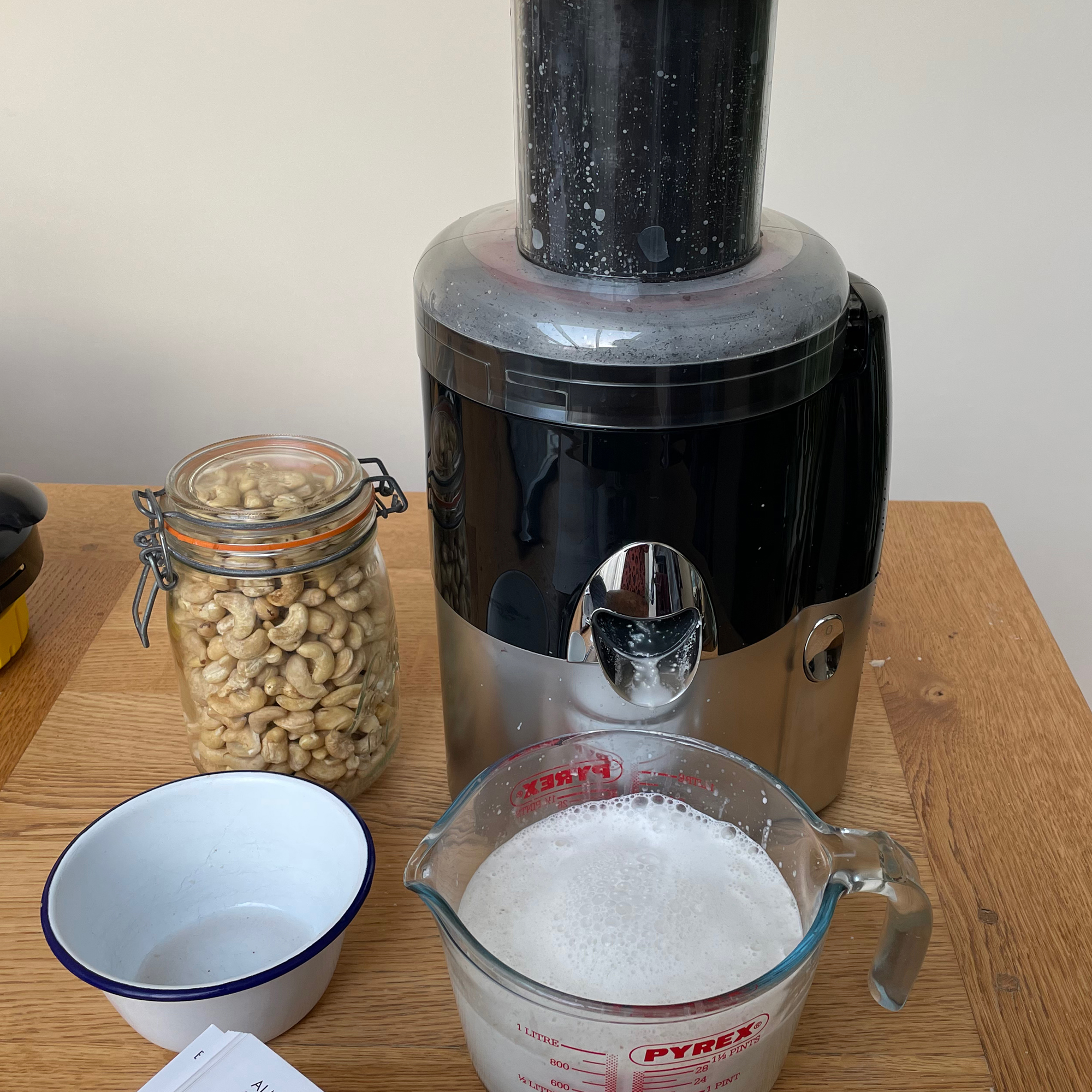
Juicing a banana
I was intrigued to see what would happen to a banana if I put it through the ‘extra press’ especially as most juicers explicitly tell you not to juice bananas. So I just put in one banana to see, and essentially it purees it. Although everything gets pushed through and there’s no waste as such, some banana does gunk up the inside of the juicer and consequently it only gave me about 60% of the banana as a puree. So for just one banana it’s quite wasteful, but if you’re pureeing a few, the percentage waste would end up being lower.
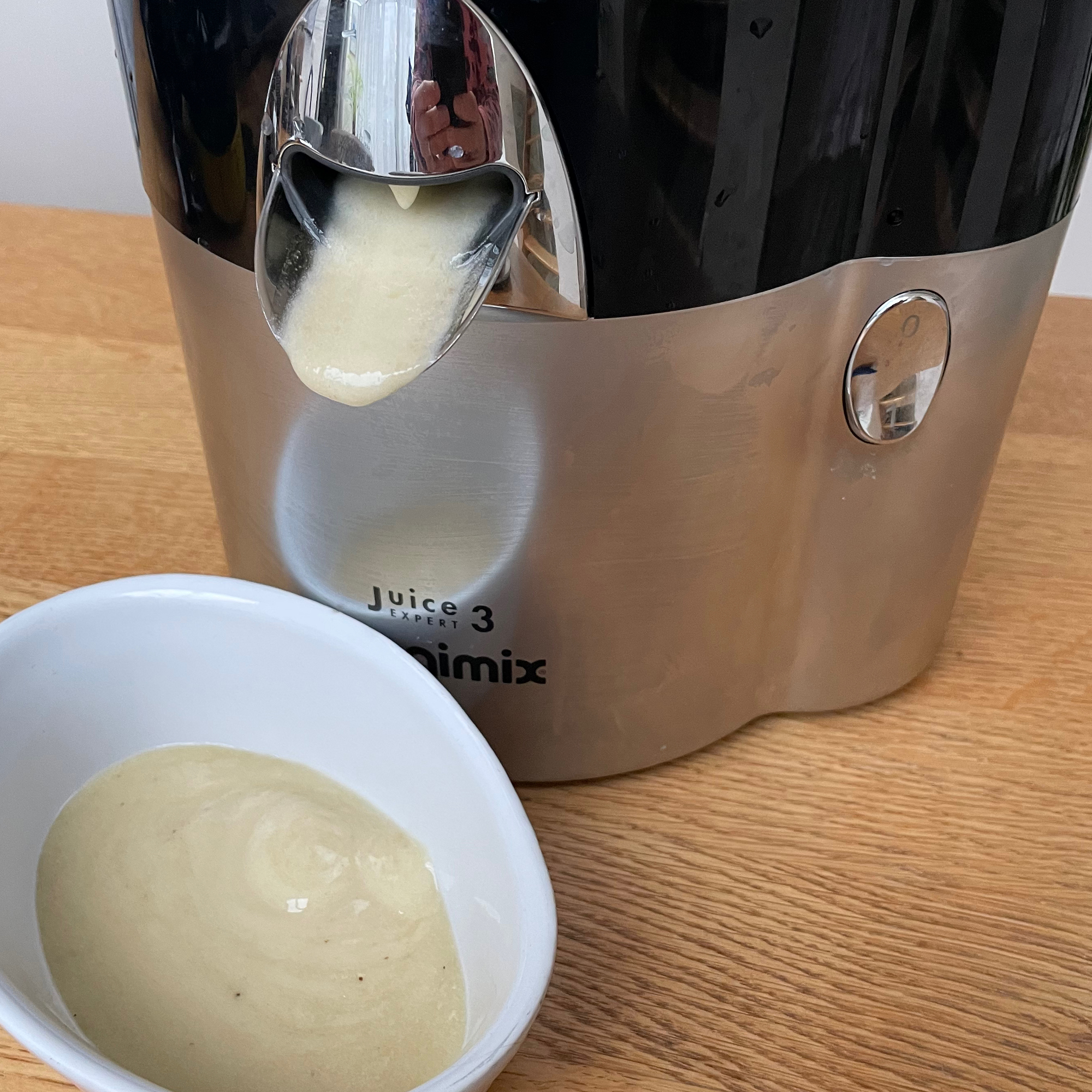
Cleaning
The juicer is simple to disassemble and though the configuration means removing the pulp isn’t as simple as tipping out a standalone pulp container, a spatula is provided to make the job of digging it out a little easier. There’s no brush provided though, so I’d advise investing in a washing up brush, otherwise cleaning the filter is tricky.
The instruction manual offers up plenty of guidance on hand washing, but the only information given regarding a dishwasher is that the minimum temperature should be selected. However the website confirms that all parts are dishwasher safe.
The various parts all wash well in the dishwasher, though I didn’t realise the top comes off the pusher, so for a while I just thought the water that had got in, was trapped inside forever more, thankfully though that wasn’t the case.
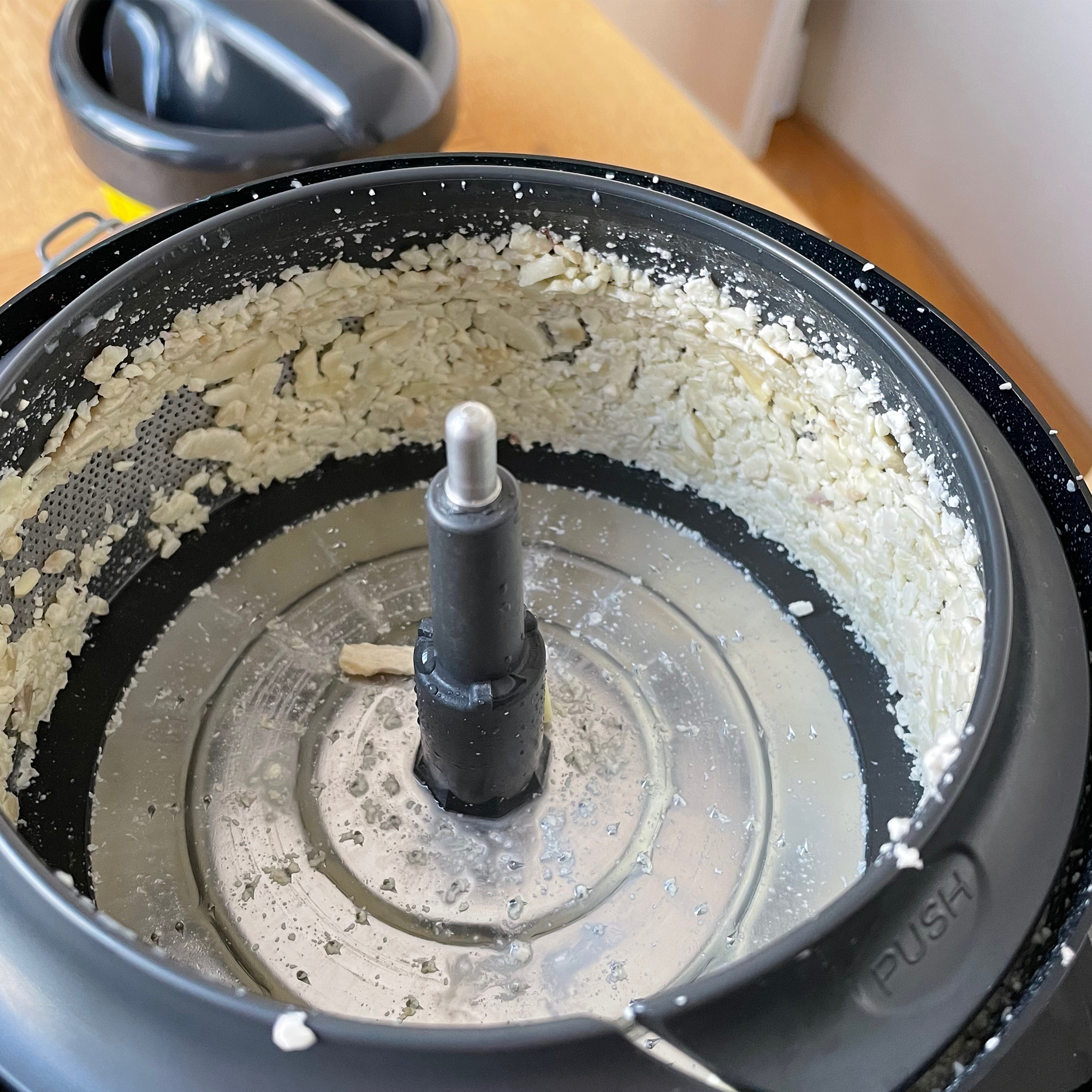
Comparisons
If you like the sound of high yields but your budget won’t stretch to the Magimix, I’d recommend taking a look at the Philips Viva Centrifugal Juicer. At under £80 it offers cracking value for money and surprisingly high juice yields too. It’s a compact space saving model, but it doesn’t come with a citrus press and can’t be used for nut milk or smoothie style purees.
Another budget friendly juicer that we love is the Nutribullet Juicer which is a great option if you’re new to juicing since it’s so easy to use. The wide feed chute means you won’t need to do any prep before juicing. But it’s bulkier than both the Magimix and the Philips models.
Should you buy the Magimix Juice Expert 3 Juicer?
At £250 this isn’t the cheapest juicer around, but if you can afford to make the step up from some of the more budget models, it’s well worth it. Plus with a 30 year motor guarantee and Magimix promising spare parts will be available for 30 years too, it’s a juicer that’s built for the long haul.
As someone who hates food waste, I’m a big fan of this juicer. It produces the minimum possible waste and I love that it has a citrus press – as this really is the best way to juice oranges. Plus, it’s simple to use, versatile and everything can go in the dishwasher. If you ask me, there really is a lot to like about this juicer.
About this review, and the reviewer
Helen reviewed this juicer alongside three others for Ideal Home, so she could make informed comparisons on speed of juicing as well as juice yields and ease of use. She’s consumed more than her fair share of juice for this review, but don’t worry, she made sure she supplemented the juice diet with plenty of pasta and cheese to keep things in balance!
Get the Ideal Home Newsletter
Sign up to our newsletter for style and decor inspiration, house makeovers, project advice and more.

After completing a Home Economics degree, Helen went on to work for the Good Housekeeping Institute and has been reviewing home appliances ever since. She lives in a small village in Buckinghamshire in the UK, where she reviews all sorts of home and garden appliances for Ideal Home using her wealth of experience.
-
 Cow print is the fashion-forward alternative to the stripe trend – how to style the look at home
Cow print is the fashion-forward alternative to the stripe trend – how to style the look at homeHow you can turn cow print from trendy to timeless
By Kezia Reynolds
-
 Shoppers are raving about H&M's new £15 patterned fitted sheets – 'I wish they would release more bedsheets like this one'
Shoppers are raving about H&M's new £15 patterned fitted sheets – 'I wish they would release more bedsheets like this one''I wish they would release more bedsheets like this one'
By Amy Lockwood
-
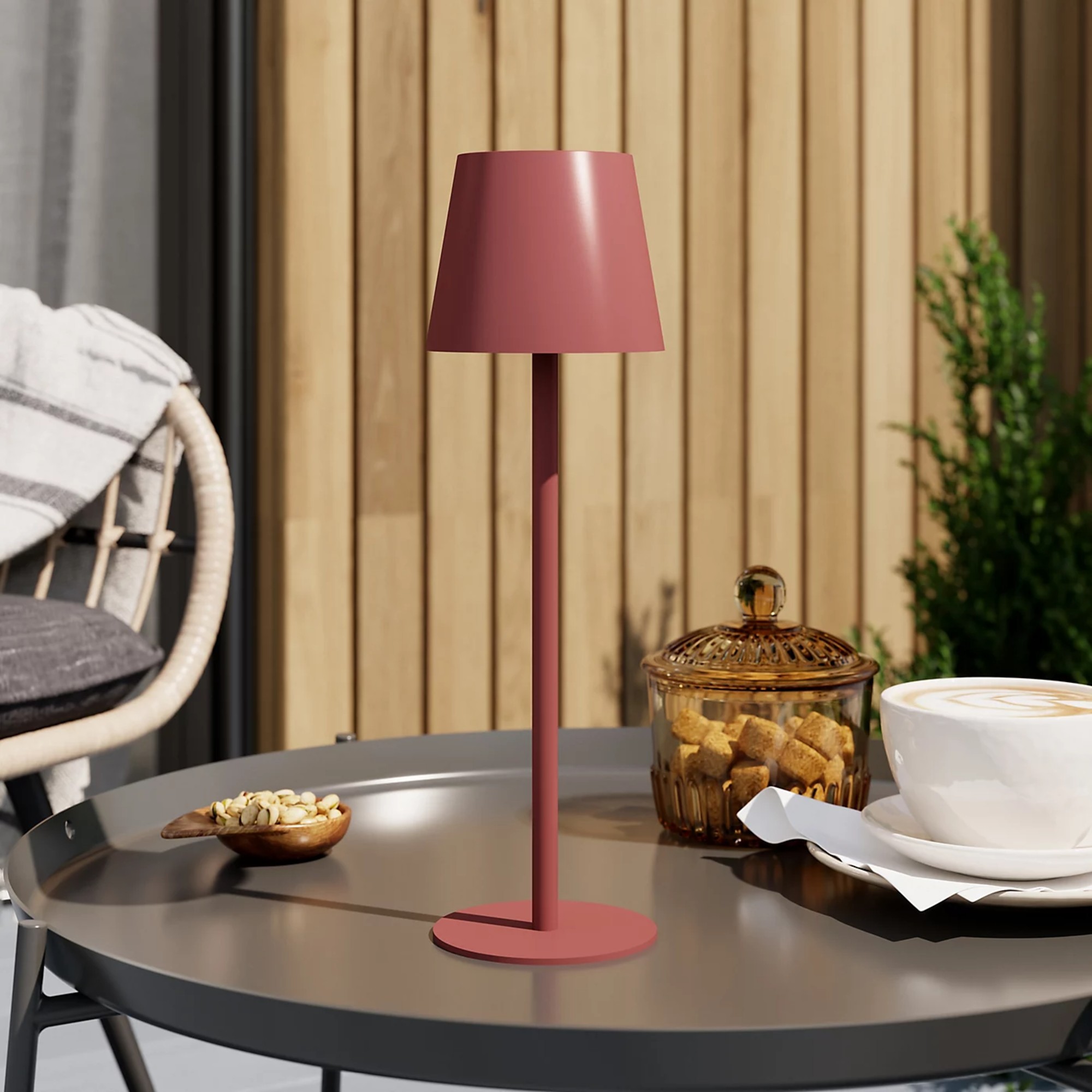 B&Q’s new wireless lamp is the perfect lookalike for Pooky’s popular Scoon lamp – and it’s only £15!
B&Q’s new wireless lamp is the perfect lookalike for Pooky’s popular Scoon lamp – and it’s only £15!If you like Pooky’s Scoon wireless lamp, you’ll love B&Q’s new lookalike selling for a fifth of the original price
By Sara Hesikova